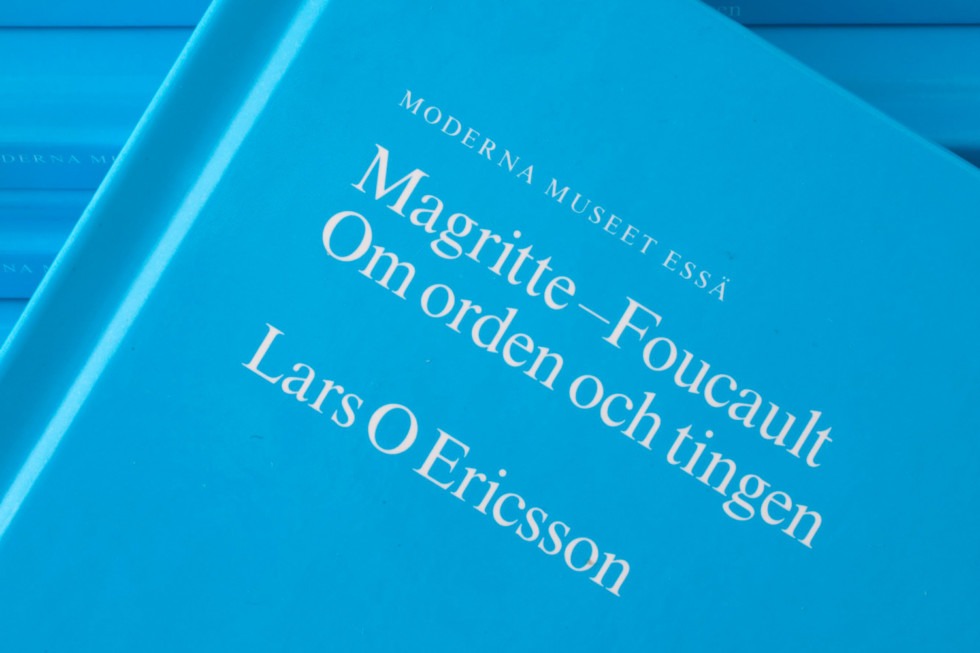Magritte-Foucault
On Words And Things
01 Sep - 04 Dec 2011

Moderna Museet Essä
Magritte - Foucault. Om orden och tingen, 2011
© Foto: Prallan Allsten/Moderna Museet
MAGRITTE-FOUCAULT
On Words And Things
1 September – 4 December 2011
Curated by Ericsson
Moderna Museet Essä is a new series of essays published jointly by Moderna Museet and Axl Books. The first title is Lars O Ericsson’s Magritte – Foucault. Om orden och tingen (Magritte-Foucault. On Words and Things), which is also the title of an exhibition in the Pontus Hultén Study Gallery
Moderna Museet Essä seeks to broaden and deepen art as a source of knowledge. This series of publications based on the flexible essay format will explore the relationship between the written word and the visual diversity offered by Moderna Museet. The essays can deal with a specific work of art, a phenomenon or a biographical description. The first volume will feature Lars O Ericsson’s essay Magritte – Foucault. Om orden och tingen (Magritte – Foucault. On Words and Things). This is also the title of an exhibition in the Pontus Hultén Study Gallery produced by Ericsson, lecturer in practical philosophy and art critic. The essay and the exhibition explore the relationship between language, image and reality.
Les mots et le choses (Words and Things) is the title René Magritte (1898-1967) chose for an exhibition in New York. This was also the title of a book by Michel Foucault (1926-1984) that was to make him internationally famous. The artist Magritte and the philosopher Foucault had a relationship of mutual respect, as their correspondence reveals. Foucault also contributed with his book Ceci n’est pas une pipe (This is Not a Pipe, which is also the title of Magritte’s most famous painting) to placing the linguistic critic Magritte at the centre of the postmodern art debate.
The exhibition ‘Magritte – Foucault. On Words and Things’ is not about paintings, perhaps not even an art exhibition in the traditional sense, but an exhibition that has a philosophical theme, namely the relationship between language and the world, between words and things. A theme that runs throughout the history of Western philosophy, from Plato to Derrida, says Lars O Ericsson.
Instead of calling himself an artist, Magritte preferred to be perceived as a thinker who expressed himself with paint. He called his works “images pensée”, thought images. He was also well-versed in philosophy, and when Foucault’s book Les mots et les choses was published in April 1966, Magritte immediately procured a copy.
It is possible that Magritte painted his last work on the theme of words and things – the painting ‘Les deux mystères’ (1966) – in connection with reading Foucault’s book. The thought is intriguing, at any rate, says Lars O Ericsson.
On Words And Things
1 September – 4 December 2011
Curated by Ericsson
Moderna Museet Essä is a new series of essays published jointly by Moderna Museet and Axl Books. The first title is Lars O Ericsson’s Magritte – Foucault. Om orden och tingen (Magritte-Foucault. On Words and Things), which is also the title of an exhibition in the Pontus Hultén Study Gallery
Moderna Museet Essä seeks to broaden and deepen art as a source of knowledge. This series of publications based on the flexible essay format will explore the relationship between the written word and the visual diversity offered by Moderna Museet. The essays can deal with a specific work of art, a phenomenon or a biographical description. The first volume will feature Lars O Ericsson’s essay Magritte – Foucault. Om orden och tingen (Magritte – Foucault. On Words and Things). This is also the title of an exhibition in the Pontus Hultén Study Gallery produced by Ericsson, lecturer in practical philosophy and art critic. The essay and the exhibition explore the relationship between language, image and reality.
Les mots et le choses (Words and Things) is the title René Magritte (1898-1967) chose for an exhibition in New York. This was also the title of a book by Michel Foucault (1926-1984) that was to make him internationally famous. The artist Magritte and the philosopher Foucault had a relationship of mutual respect, as their correspondence reveals. Foucault also contributed with his book Ceci n’est pas une pipe (This is Not a Pipe, which is also the title of Magritte’s most famous painting) to placing the linguistic critic Magritte at the centre of the postmodern art debate.
The exhibition ‘Magritte – Foucault. On Words and Things’ is not about paintings, perhaps not even an art exhibition in the traditional sense, but an exhibition that has a philosophical theme, namely the relationship between language and the world, between words and things. A theme that runs throughout the history of Western philosophy, from Plato to Derrida, says Lars O Ericsson.
Instead of calling himself an artist, Magritte preferred to be perceived as a thinker who expressed himself with paint. He called his works “images pensée”, thought images. He was also well-versed in philosophy, and when Foucault’s book Les mots et les choses was published in April 1966, Magritte immediately procured a copy.
It is possible that Magritte painted his last work on the theme of words and things – the painting ‘Les deux mystères’ (1966) – in connection with reading Foucault’s book. The thought is intriguing, at any rate, says Lars O Ericsson.
